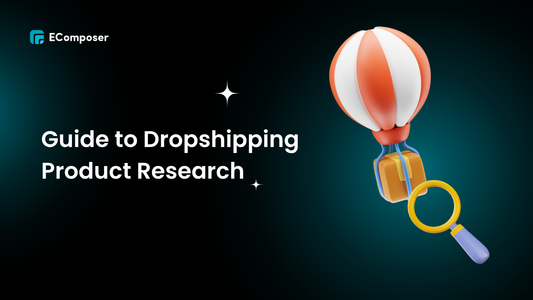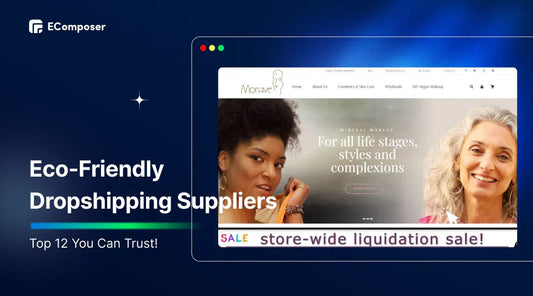Dropshipping Is a Bad Idea in 2026? Here’s Why It Fails

Table Of Contents
Dropshipping is often considered a bad idea for many new entrepreneurs, yet it still attracts a large number of people hoping to make quick money online. With low startup costs and no need to hold inventory, it is an easy path to eCommerce success for beginners.
But if dropshipping is so simple, why do most people fail? In this blog, we’ll uncover the real reasons why dropshipping is a bad idea for many and reveal what you can do instead to build a more stable, profitable online business.
Understanding Dropshipping: What It Really Is
 With the dropshipping business strategy, you sell goods online without ever keeping your own inventory. Rather, orders are stored, packed, and sent straight to your clients by a third-party provider. On paper, it is the ultimate shortcut to running an online store.
With the dropshipping business strategy, you sell goods online without ever keeping your own inventory. Rather, orders are stored, packed, and sent straight to your clients by a third-party provider. On paper, it is the ultimate shortcut to running an online store.
How does it work?
- You find a product from a supplier and list it on your website at a marked-up price.
- A customer places an order with you.
- You forward that order (along with the payment for the wholesale cost) to the supplier.
- The merchandise is shipped directly to your customer by the provider.
- The difference is your profit.
For example, if you list a hoodie for $50 but buy it from your supplier for $25, you pocket $25 (minus fees and marketing costs).
Why does it sound so appealing?
- The global eCommerce market is booming, making dropshipping look like a golden ticket.
- No upfront investment in stock or warehousing feels safer.
- Viral success stories make it seem like anyone can earn a quick fortune from home.
However, in reality, most people find themselves dealing with fierce competition, narrow profit margins, and numerous customer service headaches. While dropshipping looks easy from the outside, the behind-the-scenes work can quickly turn what seems like a simple side hustle into a stressful full-time job.
Why Dropshipping Is a Bad Idea?
Minimal Profit Margins
 One of the primary reasons dropshipping is a poor choice for many new sellers is the extremely low-profit margins. When you’re selling the same products as hundreds of other stores, price wars break out fast. Everyone scrambles to offer the lowest price to make a sale, which quickly eats away at your potential earnings.
One of the primary reasons dropshipping is a poor choice for many new sellers is the extremely low-profit margins. When you’re selling the same products as hundreds of other stores, price wars break out fast. Everyone scrambles to offer the lowest price to make a sale, which quickly eats away at your potential earnings.
Where do your profits really go?
- Paid ads: You’ll likely spend a big chunk of your budget on ads to stand out in a crowded market.
- Platform and payment fees: Shopify fees, credit card processing fees, and other charges accumulate quickly.
- Returns and refunds: Customers often return items or request refunds, and these costs are deducted directly from their pocket.
For example, let’s say you sell a gadget for $50 but pay your supplier $30. After spending $15 on ads and $3 on fees, you’re left with just $2, and that’s before dealing with any unexpected returns.
In the end, what appears to be a simple sale often turns into a minimal payout that barely covers the time and effort invested. Many new dropshippers quickly realize they’re working hard to break even rather than building real profit.
Supplier Errors Are Common
 When you rely on a third-party supplier to handle your orders, you’re putting your entire reputation in someone else’s hands. And the reality is supplier mistakes happen more often than you think.
When you rely on a third-party supplier to handle your orders, you’re putting your entire reputation in someone else’s hands. And the reality is supplier mistakes happen more often than you think.
What can go wrong?
- Customers receive the wrong items or the wrong size.
- Products arrive in poor packaging that looks cheap or gets damaged in transit.
- Shipping delays leave customers waiting for weeks, resulting in frustration and negative reviews.
Even though these mistakes aren’t your fault, your customers will blame you. You’ll have to handle angry emails, refund requests, and negative feedback, all while having little control over fixing the actual problem.
Ultimately, supplier errors can damage your store’s reputation and consume your time and resources as you attempt to rectify the situation. Many new dropshippers don’t realize how stressful and damaging these hidden issues can be until it’s too late.
High Shipping Costs
 Another major reason dropshipping often disappoints is the unexpectedly high shipping costs. Many sellers rely on international suppliers, such as those found on AliExpress, CJ Dropshipping, or SaleHoo, to source affordable products. However, while the product prices may appear attractive, shipping fees can quickly erode your profit margin.
Another major reason dropshipping often disappoints is the unexpectedly high shipping costs. Many sellers rely on international suppliers, such as those found on AliExpress, CJ Dropshipping, or SaleHoo, to source affordable products. However, while the product prices may appear attractive, shipping fees can quickly erode your profit margin.
What makes it worse?
- Long delivery times, which can sometimes take weeks or even months, frustrate customers who expect fast shipping.
- Expensive shipping fees increase your total costs, making it harder to offer competitive prices.
- Unexpected customs fees or import taxes can leave your customers angry and unwilling to order again.
Customers today expect quick and affordable delivery. When they pay extra and still wait forever to receive their items, they’re far more likely to leave negative reviews or ask for refunds. Over time, these high shipping costs and delays can damage your brand reputation, making it nearly impossible to build a loyal customer base.
It’s Extremely Competitive
 Dropshipping may seem like an easy way to make money online, but the reality is that it’s one of the most crowded business models out there. Thousands of sellers are using the same suppliers and product catalogs, which means you’re competing with countless stores offering the same items at similar prices.
Dropshipping may seem like an easy way to make money online, but the reality is that it’s one of the most crowded business models out there. Thousands of sellers are using the same suppliers and product catalogs, which means you’re competing with countless stores offering the same items at similar prices.
Why is it so hard to stand out?
- Most dropshipping products lack unique designs or features.
- Without strong branding or a unique selling point, your store appears indistinguishable from everyone else’s.
- Shoppers can easily compare prices across multiple sites and select the most affordable option.
Building a dropshipping brand in this environment is a significant challenge. Rather than cultivating a devoted clientele, you end up in a race to the bottom, fighting on price rather than value. Many new dropshippers find themselves spending more on ads and promotions to stay visible, only to realize they can’t compete long-term without offering something truly unique.
No Control Over Inventory
 One of the most frustrating parts of dropshipping is having no control over your inventory. Since you rely completely on third-party suppliers, they can run out of stock at any time without warning. You often have no real-time visibility into what’s available, so you might keep selling products that are already unavailable.
One of the most frustrating parts of dropshipping is having no control over your inventory. Since you rely completely on third-party suppliers, they can run out of stock at any time without warning. You often have no real-time visibility into what’s available, so you might keep selling products that are already unavailable.
What problems can this cause?
- Customers place orders, only to find out later that the item is sold out.
- You’re forced to issue refunds or offer replacements, which damages trust.
- Negative reviews pile up as shoppers feel misled and disappointed.
When you can’t guarantee product availability, it’s almost impossible to build a reliable shopping experience. Many dropshippers spend more time apologizing and fixing mistakes than actually growing their business. Over time, this lack of control can harm your reputation and drive customers toward more reliable competitors.
Dropshipping Isn’t as Easy as It Sounds
 Many people jump into dropshipping, thinking it’s a quick, hands-off way to make money online. In reality, it’s far from passive. Behind every “easy” sale, there’s a long list of daily tasks that demand your attention.
Many people jump into dropshipping, thinking it’s a quick, hands-off way to make money online. In reality, it’s far from passive. Behind every “easy” sale, there’s a long list of daily tasks that demand your attention.
What really happens behind the scenes?
- Constantly testing and tweaking ads to find what actually converts.
- Handling customer questions, complaints, and refund requests.
- Managing returns, tracking orders, and dealing with shipping issues.
- Updating product listings and checking stock availability.
Instead of sitting back and watching the money roll in, you’ll often find yourself glued to your laptop, putting out fires and trying to keep customers happy. For many, it quickly becomes a stressful, full-time job rather than the flexible side hustle they had imagined.
Legal Liability Issues
 Many new dropshippers overlook the legal risks associated with selling products they don’t control. If a customer receives a faulty or dangerous product, you’re the one they hold responsible, not the supplier. Even if the mistake isn’t your fault, you’re still on the hook for refunds, damages, or even legal action.
Many new dropshippers overlook the legal risks associated with selling products they don’t control. If a customer receives a faulty or dangerous product, you’re the one they hold responsible, not the supplier. Even if the mistake isn’t your fault, you’re still on the hook for refunds, damages, or even legal action.
Why is this so risky?
- Most suppliers don’t offer clear product warranties or guarantees.
- You have little to no control over product quality or safety checks.
- Handling legal claims can lead to costly settlements and hurt your brand reputation.
When problems arise, customers won’t chase a supplier overseas. They’ll come straight to you. This hidden legal liability can turn a seemingly simple business into a stressful and expensive nightmare if you’re not prepared.
How to Make Dropshipping Work (If You Still Want to Try)
 Although dropshipping is often considered a bad idea for most, some sellers still manage to turn it into a profitable business by planning carefully and working smarter. If you’re set on giving it a shot, here’s how to stack the odds in your favor.
Although dropshipping is often considered a bad idea for most, some sellers still manage to turn it into a profitable business by planning carefully and working smarter. If you’re set on giving it a shot, here’s how to stack the odds in your favor.
Do Real Market Research
- Avoid generic products, such as phone cases, inexpensive jewelry, or miscellaneous gadgets. Everyone sells these, and the margins disappear fast.
- Look for specific problems you can solve. For example, eco-friendly kitchen tools for home cooks, ergonomic pet carriers for travelers, or hobby tools for gardeners.
- Use Google Trends to see if people are actively searching for your product idea. Ecomhunt and TikTok Creative Center can help you find items that are rising in popularity but not yet flooded with sellers.
For example, instead of another “trendy phone case,” think about cases designed for niche hobbies or specific professions.
Avoid Overselling
- Always check supplier stock levels before running ads or pushing big promotions. Some apps can automatically sync inventory to prevent mistakes.
- Write clear shipping and delivery information on every product page. If a product takes 20 days to arrive, tell your customers upfront.
- Never claim “fast shipping” if your supplier can’t guarantee it. Angry customers and refund requests will cost you far more than any quick sales.
Use Shipping Software & Fewer Suppliers
- Utilize order automation tools to streamline fulfillment, minimize human error, and optimize time efficiency. This frees you from chasing orders so you can concentrate on marketing and customer service.
- Work with one or two reliable suppliers instead of many. Building strong relationships helps you negotiate better pricing, get faster support, and have more accurate stock info.
- Before committing, order samples to check the quality and ensure accurate delivery times.
Offer Great Customer Support
- Fast, friendly support is your secret weapon. Try to respond to all emails and texts within a day, or sooner if you can.
- Create an FAQ page that covers shipping times, returns, sizing, and frequently asked product questions. This reduces the volume of support tickets and builds trust.
- Utilize live chat on your website to provide visitors with instant answers, which often boosts conversion rates and enhances the shopping experience.
Build a Branded & Professional Website
- Invest in a clean, modern design with clear navigation. A messy website scares away buyers before they even consider your products.
- Write unique product descriptions that highlight benefits and tell a story. For example, instead of saying “soft yoga mat,” describe how it supports comfort during long practice sessions and helps reduce joint pain.
- Use high-quality, original photos. Avoid using supplier photos that appear cheap or are shared by numerous other stores. Adding lifestyle images can help customers imagine using your products.
If you follow these steps, you’ll give yourself a much stronger foundation. Dropshipping isn’t passive or easy, but with careful research, reliable systems, and a strong brand, it can still be a profitable endeavor. Treat it like a serious business from day one, and you’ll be far ahead of most beginners who jump in unprepared.
Read more:
- How to Create a Dropshipping Business Plan
- Best FREE Dropshipping Suppliers and Companies
- Is Dropshipping Legal? How To Avoid Pitfalls
What Is the Hardest Part of Dropshipping?
 The hardest part is picking a product, but the real struggles come later and catch most beginners off guard.
The hardest part is picking a product, but the real struggles come later and catch most beginners off guard.
Building trust without a real brand
- Consumers want to purchase from well-known brands, not random stores that look cheap or temporary.
- Without a strong brand story and clean design, it’s tough to convince people to trust you.
Managing customer expectations
- Long shipping times, inconsistent product quality, and confusing return policies frustrate buyers fast.
- If expectations aren’t clear, you’ll face refund requests and bad reviews nonstop.
Running profitable ads consistently
- Paid ads require ongoing testing and optimization to remain profitable.
- One bad campaign can quickly deplete your budget and leave you with a loss.
Dropshipping success isn’t about shortcuts. It takes real skills, patience, and smart strategy to overcome these tough challenges.
FAQs
Is dropshipping still profitable?
Yes, it can still be profitable, but it’s much harder now. With more competition, higher ad costs, and customers demanding faster shipping, you need strong marketing skills, a unique niche, and a clear brand to stand out.
How much money do I realistically need to start dropshipping?
Most people need at least $1,500 to $3,000 to start properly. This covers store setup, product samples, ads, apps, and some cash for unexpected costs. Starting with less usually means cutting corners and struggling to make sales.
How long does it take to succeed with dropshipping?
It depends on your skills and the effort you put in. Some sellers see results in a few months, but for most, it takes 6 to 12 months (or longer) of consistent testing and learning before they become profitable.
Does dropshipping work for beginners with no experience?
It’s possible but not easy. Beginners often underestimate the time and money needed to learn ads, build a brand, and handle customer service. Without proper research and commitment, many end up quitting early.
How do I choose reliable dropshipping suppliers?
Order samples first to check quality and shipping speed yourself. Stick with suppliers who communicate clearly, have good reviews, and update you on stock levels. Fewer trusted partners are better than many random ones.
What are the best alternatives to dropshipping?
Consider print-on-demand, creating your own branded products, or purchasing small batches of inventory to control quality and shipping. These models usually offer higher margins and more control over your business in the long run.
Conclusion
Dropshipping may sound easy, but it’s full of hidden challenges. From slim profit margins and supplier mistakes to high ad costs and fierce competition, many beginners quickly get overwhelmed and give up.
That doesn’t mean success is impossible, but it’s definitely not a quick or easy path. If you still want to try, be prepared to invest a significant amount of time, effort, and patience in building a strong brand and keeping your customers coming back.





















0 comments